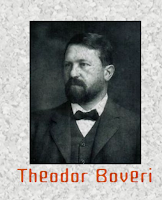The Boveri–Sutton theory of chromosomes
This theory gives a new life to Mendel’s works. Mendel published his work in 1865 but nobody noticed his work until the 19th century ended.
Mendel got recognition and popularity at the beginning of the 20th century when he was dead.
Walter Sutton and Theodor Boveri are the two scientists who developed the chromosomal theory of inheritance. They both work independently.
Sutton works on the grasshopper and gives his hypothesis while Boveri works on sea urchins and gives his hypothesis.
Both hypotheses were accepted and made a theory that we called as Boveri-Sutton theory or chromosomal theory of inheritance.
Walter Sutton.

Walter Sutton

Walter Sutton, was an American geneticist and physician. At the beginning of the 20th century (1902), he was working on the grasshopper for the study of chromosomal behavior.
He found that chromosomes are in pairs, one comes from the mother and the other came from the father. Chromosomes get separated from each other as Mendel says in 1865.
Theodor Boveri
At the same time, another scientist, Theodor Boveri was working on sea urchins. He told that it is important for embryonic formation that complete numbers of chromosomes are present there.
The combining work of these two scientists makes a theory that we call the theory of inheritance or the theory of chromosomes.
According to this theory, genes are found on chromosomes with specific locations. During the cell division, it is separated as explained by Mendel in 1865.
We can compare the theory of chromosomes and Mendel's work:
- According to the theory of inheritance, the chromosomes are found in pairs and according to Mendel, factors are also in the form of pairs.
- One chromosome comes from the mother while the other comes from the father. And this is exactly said Mendel that one factor comes from the mother while the other comes from the father's side.
- Chromosomes get separated during cell division and this same thing is explained by the Mendel law of segregation that factors separate from each other during gamete formation.
- Chromosomes assort independently as in Mendel’s law of independent assortment.
- Chromosomes can be seen in all dividing cells pass from one generation to the next, and are the basis for all genetic inheritance. In Mendel’s terms, factors also pass from one generation to another generation.

%C2%A0.png)




.png)
.png)
%C2%A0.png)
.png)

.png)

.png)
.png)

0 Comments